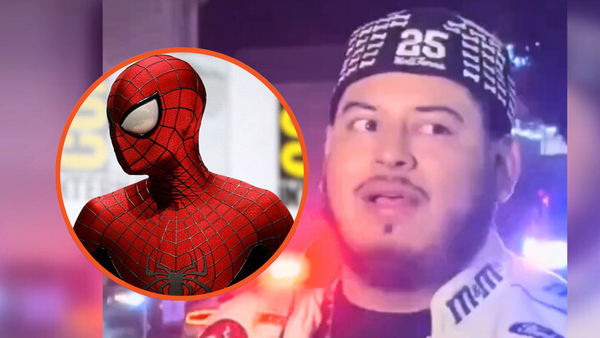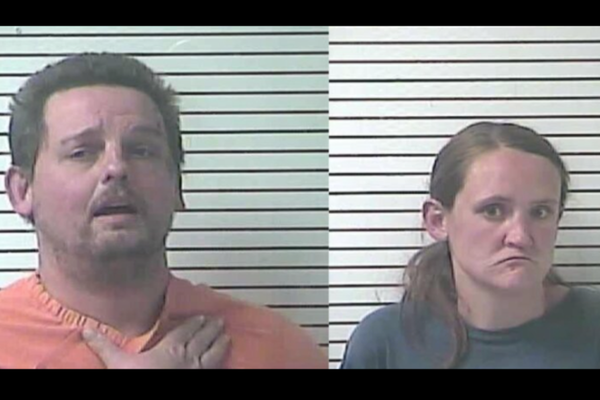
Diego Luna is video-calling from his home in Mexico. “I’m sneaking out of the family breakfast to speak to you,” says the 42-year-old actor, holding up his phone so I can see his two children and assorted other figures in the dining room behind him as he wanders into the garden. Noticing that the wifi is unstable, he turns off the camera. “But first I wanted to show you my face,” he laughs, “so you can make sure it’s really me.”
It’s him all right. He may be wearing sunglasses and a baseball cap but the boyish grin is unmistakable, and unchanged since the 2001 road movie that made him a star: Alfonso Cuarón’s Y Tu Mamá También, featuring Luna and his real-life best chum Gael García Bernal as priapic young blades on a life-changing trip with an older woman.
The actors had been friends for many years, having grown up as child stars of Mexican television. (Luna’s British mother, Fiona, died in a road accident when he was two; he was raised by his father, Alejandro, a set designer for theatre and film.) Though Luna landed a small part in Julian Schnabel’s Oscar-nominated Before Night Falls, it was his performance in Cuarón’s movie that showed the range of his talents, from bawdy knockabout comedy to plangent emotional honesty. The climax, in which the friends’ threesome with their travelling companion, who has already bedded them both individually, blurs into an expression of gay desire for one another, was a moment of genuine daring and candour.
That film kickstarted a career that has seen Luna switch effortlessly between Hollywood extravaganzas and smaller, homegrown Spanish-language projects, many of them socially or politically conscious. But mention the movie that started it all for him and it becomes clear that the years haven’t dulled his affection for it. “We had our characters’ energy,” he recalls. “We were teasing each other nonstop, morning to night, competing in everything; if there were five-minute breaks on set, we would grab stones and see who could throw them the farthest, or who could hit that target. There wasn’t a moment when we weren’t teasing this person or that person, and getting into all these little dramas. I think in a way we became a little addicted to it all: the intimacy and feeling like part of the family.”
There have been whispers of a sequel that might call in on the characters in their 40s. Luna even told the New York Times last year that he didn’t believe the claim by the film’s narrator that the two friends never saw one another again. Today, however, he turns his nose up at the idea. “Going back would be …” He thinks for a moment. “It could be a disaster!” he says finally. “I don’t think it’s worth it. It was special and unique, but it was part of its time. Films like that are like marks on the ground – they’re a reminder of something that happened and is gone. We cannot just say: ‘Let’s do it again.’”
Prequels, though, are another matter. In Andor, the new TV spin-off from the endlessly proliferating Star Wars franchise, Luna plays Cassian Andor, the intergalactic rebel he originated in the 2016 blockbuster Rogue One: A Star Wars Story. Set immediately prior to the events of the 1977 movie that started it all, Rogue One showed a ramshackle group of heroes paving the way for the likes of Luke Skywalker, Princess Leia and Han Solo. It concluded with Cassian and his fellow fighters dying in a blaze of glory. Now, Andor rewinds to many years before that to show the character’s humble beginnings: it’s a prequel to a prequel.
The grin doesn’t get much of an outing in Andor. It may be set a long time ago in a galaxy far, far away, but initial episodes (the fourth episode will air this week) go less for the George Lucas sheen than a Blade Runner-style neon-and-drizzle murkiness, punctuated by occasional woodland skirmishes.

Being the first standalone Star Wars instalment lent Rogue One a distinctiveness not afforded to the nine central films of the franchise, and Luna sees Andor as a continuation of the film’s boldness. “We don’t have to prove anything,” he says. “The characters exist in the grey areas. It’s about the journey of real people – the most real you can get in Star Wars. Their hopes are broken. Everyone is oppressed. There is this feeling of ‘something needs to happen’. We know Cassian will become a hero, but we can challenge the idea that there is only one way. Fortunately, we work with a writer who lives in that kind of complexity.”
He is referring to Tony Gilroy, who created Andor, and was previously best known for scripting the Bourne action series. Gilroy was also the man who saved Rogue One. “Well, uh, I would say that is not the right way to put it,” replies Luna with a nervous giggle. I’m surprised to hear that, because this is precisely how Gilroy describes it. He was hired by Disney as an emergency script-doctor before overseeing reshoots that fixed or augmented what the director, Gareth Edwards, had already done. “They were in such a swamp,” Gilroy said in 2018. “They were in so much terrible, terrible trouble that all you could do was improve their position.”

When I recount that to Luna, he laughs again, more heartily this time, as though he is eight years old and I’ve just said a naughty word. “I would agree that Tony brought complexity to my character,” he says. Why the reluctance to admit that the shooting of Rogue One ran aground? “It’s important to highlight that there is no single way to get to any destination. To me, Rogue One is a film that took so many risks.” Now the problem becomes clear: he thinks I’m disparaging the movie, when nothing could be further from the truth. In fact, I think it’s the second-best Star Wars episode in the entire series, characterised by unusual daring and finesse and trumped only by The Empire Strikes Back. “I love you for saying that,” he says. “I didn’t say it. But if you’d got me drunk, I would have said the exact same words.”
He must have realised how messy things were getting before Gilroy fixed them? “Oh, of course,” he says, relaxing into the subject at last. “Making Rogue One was difficult, challenging and confusing sometimes. But films finish when they finish. I’ve been in so many projects where you think things are going exactly the way they should, then it turns out not to succeed. The struggle of finding what each film needs, and how to do it, is unique. Every decision made in Rogue One ended up being right because I’m proud of the result.”
Luna’s first encounter with Star Wars was on video in the 1980s. “All my older cousins were already fans. I was the youngest and I wanted to catch up. My experience was like streaming is today: it was uncontrolled. I could press play as much as I wanted.”
Is it not the case now, though, that there is simply too much Star Wars content? With The Mandalorian, The Book of Boba Fett and Obi-Wan Kenobi already streaming, and Andor, Ahsoka, Skeleton Crew, The Acolyte and Lando crowding the horizon like a meteor shower, it is no wonder that James Waugh, the senior vice-president of Lucasfilm, has admitted to being “mindful” of oversaturation. After all, the disappointing response in 2018 to Solo: A Star Wars Story, a prequel that was widely perceived as a case of flogging a dead Wookiee, led to Disney scaling back its slate of movies in the franchise. Luna bats away such concerns. “I disagree. Not everything has to be for everyone. And these are so diverse and complex, come on! My father likes them, I like them, so do my kids.” Polling outside his immediate family might yield different results, or perhaps not.
Luna is a film-maker himself – his work behind the camera includes the political drama Cesar Chavez and Everything Will Be Fine, a lively, funny and candid Netflix drama series about divorce, both made under the aegis of his own production company, which he co-founded with Bernal. The pair will soon reunite on screen for the Hulu series La Máquina, with Luna as the manager of an ageing boxer played by Bernal, and his other acting choices have always been pleasingly eclectic. He may have worked with Steven Spielberg (The Terminal) and Woody Allen (A Rainy Day in New York) but he was also in the gay rights drama Milk, the artful James Baldwin adaptation If Beale Street Could Talk and the bizarre Mister Lonely, where he played a Michael Jackson impersonator living in a Scottish castle with other celebrity mimics.

With such offbeat projects in mind, it must be a concern that Star Wars and Marvel blockbusters leave little room in the market for independent voices. “I agree with that,” he says. “But I’m optimistic about how the space is divided, the different venues and platforms we have now.” He is also realistic about the effect of the Star Wars universe, or his role as a cartel kingpin in Narcos: Mexico, on his own clout beyond those series. “I was naive at the beginning. I thought: ‘Of course, after Rogue One I can do whatever I want and put it out there.’ No. You can do another Rogue One, or something of that scale, but it doesn’t mean you can go back and do a tiny film and have it released in the same way, or given the same sort of push.”
Despite this, he retains a sense of wonder about cinema that can be traced directly to his youth. Though he began his acting career as a child in Mexican telenovelas, he was no stranger to arthouse film-making: he visited the sets that his father worked on, most memorably Alejandro Jodorowsky’s surreal and gruesome circus fantasy Santa Sangre. “Parts of the elephant from that film were kept at home,” he recalls. “So I didn’t freak out when it started spurting blood from its trunk because I knew how it all worked. Remember the tattooed woman? I sat in the trailer for hours watching her being painted!”
Most of all, he cherishes the memory of seeing the models his father would make on the table at home transformed weeks or months later into colossal constructions. “He would have these miniature sets with tiny figures, and he would back-light them and front-light them and move the figures around to analyse the effect. Then it would all be built on a stage and it would become enormous!” With that, he makes an exploding noise – the sound, presumably, of his young mind being blown. Perhaps another child somewhere out there will have the same experience with Andor.
• Andor is streaming now on Disney+







